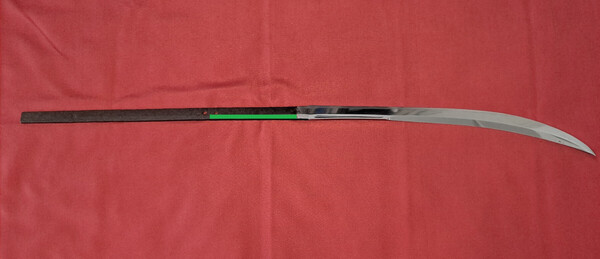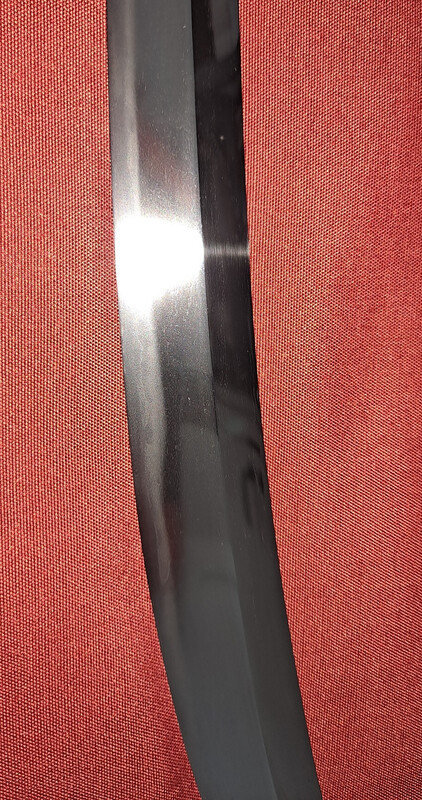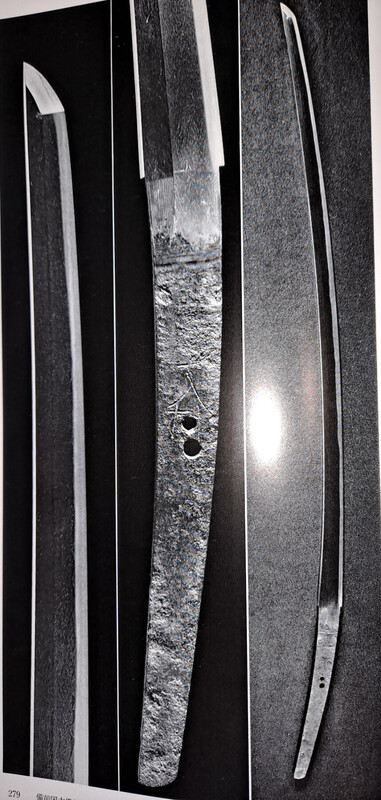-
Posts
2,170 -
Joined
-
Last visited
-
Days Won
37
Content Type
Profiles
Forums
Events
Store
Downloads
Gallery
Everything posted by Jussi Ekholm
-
I am very happy to see people participating. Having fun in researching & guessing is the most important thing. I will post the answer on Tuesday and small write up that I have made.
-
You have wonderful items in your collection Gary
-
I think the first letter in horimono is 南 making the beginning Namu 南無. Sorry for bit limited reply as I am typing on phone.
-
-
Interesting find George
-
I remember I was in for just the signed book, and for me it was just written off as a support for the artist few years after the supposed delivery date. However I know there are some people that made very generous contributions towards the project. I know Ford is an amazing craftsman and researcher but unfortunately his business skills are quite lacking.
-
Looks like a nice find Mark. I am not well versed on Masahiro but I would think the signature would be plausible. As I saw the announcement that NTHK is holding a shinsa at San Fran, I think this one might be up for that? I think I can post some mei references tomorrow, I think I should have at least somewhere around 15-20. I can check them tomorrow and post few that seem the closest to my eye.
-
Here is info from Markus Sesko about Numata Naomune, the smith who made this sword. I am not familiar at all with this smith but here are some reference items for you. https://www.seiyudo.com/wa-070316.htm https://www.e-sword.jp/sale/2009/0910_1089syousai.htm https://www.nipponto.co.jp/swords5/KT330787.htm (Arimune) I think one notable thing about the blade at Aoi is the early date too, and of course the great length and shape.
-
I think the smith would be - 築樋利広 - Chikuhi Toshihiro
-
Well it's been a while since I posted a kantei topic last time. So I thought why not do it again as I felt the last one was really fun. I hope everyone would enjoy and participate, as it's not too serious. The idea behind this is getting people activated and having fun. The item in question is something that is maybe not too often for kantei, a naginata. I have tried my best on taking photos but unfortunately they are not nearly at the level some members can take pictures. I hope that some details can be seen from the pictures. I have also tried to write a small text following the NBTHK format, having measurements and some text, which should be helpful in the identification process along with the pictures. I might have missed some details as my eye for details is not the best. Also all of the text is written by me so any errors are my errors. All of the pictures are from the same side as unfortunately there is large difference in condition between the 2 sides. I think I will let this run about a week to week and half. So that people interested will have some time to hopefully participate. Naginata Measurements: Nagasa: 45,8 cm Sori: 2,3 cm Motohaba: 2,6 cm Motokasane: 11mm Nakago-nagasa: 44,2 cm Nakago-sori: None Shape: Kanmuri-otoshi-zukuri, iori-mune, mihaba slightly narrow, slight saki-zori, there is some widening towards the cutting area. Forging: Itame with some mokume mixed in, some nagare that is standing out, ji-nie. Small notare with gunome peaks, sunagashi and nie. Utsuri is slightly visible. Bōshi: Sugu with ko-maru Horimono: On both sides naginata-hi Nakago: Ubu, end slightly shortened, 2 mekugi ana, nagamei on omote side and date on ura side.
-
Like said above, very nice blade and by a good smith
-
I think the signature is - 東山住大江美平 - Higashiyama jū Ōe Yoshihira. The smith was from latter part of 1600's.
-
I am not too proficient with WWII smiths but I believe the signature is - 濃州関住服部正広作 - Noshū Seki jū Hattori Masahiro saku. Like George identified above. You can see reference mei here: https://www.aoijapan.net/katana-gunto-noshu-seki-hattori-masahiro-saku/
-

Translation help on gendai sword
Jussi Ekholm replied to matthewbrice's topic in Translation Assistance
I think it it is - 崎陽住松林政重造之 - Kiyō jū Matsubayashi Masashige kore o tsukuru -

Inazuma, sunagashi, imozuru - or?
Jussi Ekholm replied to george trotter's topic in General Nihonto Related Discussion
Here is a very amateur attempt for the Shigetsugu hamon part. Hamon is gunome mixed with ko-chōji, with ko-nie. (I am not sure how nioi is described), ashi are running towards cutting edge, (light?) sunagashi with some roughness (pockmarked?). Some of the adjective descriptions are usually very difficult for me to read and understand as my language is not at that level and I have to rely on translation programs and common sense when trying to figure some out. For the last picture, it is just a reference hamon style of smith (and for others who made similarish work, listed besides). 8. Masamune - 9. Norishige - 16. Motohira - 17. Kiyomaro. -

Shosoin and the imperial collection after WW2
Jussi Ekholm replied to jsv's topic in General Nihonto Related Discussion
Well maybe not realistic but it is fun. As for me this hobby is just mostly about seeking information on various items rather than having them. I agree with you that finding items that were once part of Daimyō etc. collections would be really fun. Likewise finding the items published in very old oshigata books etc. Here is Shintōgo Kunimitsu blade that seems to have been once part of Shimazu collection: https://www.nipponto.co.jp/swords8/TT328774.htm at least it is presented as such. (However this has been through several dealers in Japan even online). I've been eyeing to get that book for myself too, as well as few books on Imperial collection swords & Shōsōin swords. There are just way too many interesting books out there. -

Shosoin and the imperial collection after WW2
Jussi Ekholm replied to jsv's topic in General Nihonto Related Discussion
There might be some things that would be written differently today. The article is soon 30 years old, likewise Yamanaka Newsletters were written 50 years ago. Lots of things have changed since they were written, there are indeed some things that I would for example write differently. However that is probably most up to date info on the missing swords found that I have currently access to. I do know some other significant finds from other sources as well. Perhaps an up to date list should be combined by our members together? -

Shosoin and the imperial collection after WW2
Jussi Ekholm replied to jsv's topic in General Nihonto Related Discussion
One thing to note that Yamanaka Newsletters were written in late 60's to early 70's. Some of the missing items have been found since then. Jim Kurrasch wrote and updated list on 1996, which can be seen on Rays site: https://swordsofjapan.com/important-missing-nihonto/ And the finds have been continuing on occasional basis even to this day. What is more shocking to me that there are currently a fair amount (c.60 or so) of Jūyō Bunkazai swords in Japan of which the current whereabout is not know to Agency for Cultural Affairs. I am not sure how and why some of those items have gone under the radar. -
It was this tachi by Ko-Bizen smith Tomomura. You can read the story of by Jim Kurrasch from Rays site: https://swordsofjapan.com/tomomura/ It shows how business side of this hobby is often extremely harsh. The sword was originally owned by Yusuhara Hachimangū before WWII occupation and I believe it has not yet been returned to the shrine (I know they have 3 Bunkazai at present time). The sword was in Japan I believe late 1994, where NBTHK team (including Tanobe-sensei were able to research it, and it was the feature sword of TB 456). I am hoping the sword will some day return to Japan and the shrine.
-
I agree with the analysis by Kirill and Paul above. I checked Bungo Taikan and there are 3 Yukizane smiths listed but none would fit the age of this wakizashi.
-
I think it is - 小島勝正作 - Kojima Katsumasa saku
-
As far as signed tachi go, Aoe school as well as Hōju school were sometimes writing on opposite side that was commonly used, there are some other exceptions too. However as they are generally very old swords they were made as tachi regardless of the side of the signature. Well one could argue that in some cases there would be 0 difference between some tachi and katana (if size and shape are looked at) and they would be correct. For mumei I think in general if the alteration to nakago is only slight NBTHK will classify it as tachi if it retains enough of it's original shape. I think the Mumei Ichimonji example (3rd one on those you listed) has me puzzled. NBTHK mentions it is almost ubu, and their expertise is far greater than mine. However it appears to me to have been shortened some amount. It is puzzling... Here is a mumei example attributed to Ayanokōji school tachi and nakago is almost ubu, only very slight alteration: https://www.aoijapan.com/katana-mumei-attributed-as-ayanoko-ji-ntbhk-the-43th-juyo-token/ I think the only complicated divider would be when a tachi is mumei and slightly altered. If it would be accepted as almost ubu it will still achieve it's classification as tachi, however if a mumei sword is deemed suriage then it will be classified as katana. There is also a term slight suriage that NBTHK sometimes uses that is sitting just about at this dividing point. I can try to look into the NBTHK Jūyō papers more closely tomorrow, this is just from the top of my head. I think the den Nobukuni example is very interesting one. It was papered with old system and I would think of it as a tachi from possibly early Muromachi period. I am looking at the picture and trying to figure out if it had had possibly a signature removed. I am not a gambling man but that could be nice one to look closer, however I think the 1,8M asking price drives me away.
-

Square Mekugi-Ana...a thing?
Jussi Ekholm replied to waljamada's topic in General Nihonto Related Discussion
Just noticed that Christian linked to an article by Markus above which had the info I was about to write on holes on Dans blade and so much more too. The square hole is referred as masugata 枡形. Here is an example on my tachi from early Muromachi. I think the square hole is original hole for tachi mount and round hole later addon when it was mounted as katana. -

Darcy Brockbank
Jussi Ekholm replied to Ted Tenold's topic in Sword Shows, Events, Community News and Legislation Issues
My condolences to the family & friends, a devastating loss to the community. -
I am not confident on calling the signature either way, but if possible I think it should be evaluated by Japanese shinsa team at some point as was suggested earlier. Here are 4 reference signatures from Norimitsu dated to Bunan. I think I should have around 10 or so of these around in total. There are some variations in signatures so even though I see some points in yours that might not fit 100% with these examples, you can see variation within verified examples too. https://iidakoendo.com/623/ https://web.archive.org/web/20210612205552/https://www.seiyudo.com/wa-010714.htm https://ginza.choshuya.co.jp/sale/gj/r4/002/09_norimitsu.htm https://www.e-sword.jp/sale/2015/1510_2015syousai.htm You can see the last one linked has quite similar shape & size to yours.















.thumb.jpg.01ff247925f2b084ce5cb541e602606e.jpg)